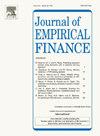短期动能和反转、换手率以及股价与 52 周最高价的比率
IF 2.4
2区 经济学
Q2 BUSINESS, FINANCE
引用次数: 0
摘要
我们的研究表明,短期反转行为会随着股票换手率和上月价格与 52 周最高价之比(PTH)的下降而下降,对于换手率和 PTH 都相对较高的股票,短期反转行为会转向动量。连续一个月的个股收益率的这种行为对子周期分析、风险调整和替代方法都是稳健的。我们的研究结果表明了两种截然相反的渠道。首先,在促进短期动量方面,我们的证据意味着 PTH 锚定对近期新闻的反应不足,这与 Atmaz 等人(2024 年)的短期逆向价格抑制渠道一致,较高的换手率意味着逆向引起的反应不足更强。其次,在促进短期反转方面,我们的证据加强了众所周知的流动性供应补偿渠道的重要性。低 PTH、低换手率股票的反转尤其强烈,PTH 越低意味着股票市值越小、流动性越低,换手率越低意味着逆向投资引起的反应不足越弱。我们还发现,收益行为随分析师盈利预测的离散度和整个市场情绪的变化而变化,这与这些渠道是一致的。本文章由计算机程序翻译,如有差异,请以英文原文为准。
Short-term momentum and reversals, turnover, and a stock’s price-to-52-week-high ratio
We show that short-term reversal behavior declines with a stock’s turnover and the prior month’s price-to-52-week-high ratio (PTH), shifting to momentum for stocks with both a relatively high turnover and PTH. This behavior of consecutive one-month individual stock returns is robust to subperiod analysis, risk adjustments, and alternative methodologies. Our findings suggest opposing channels. First, promoting short-term momentum, our evidence implies a PTH-anchoring underreaction to recent news, consistent with the short-term contrarian price-dampening channel of Atmaz et al. (2024) with higher turnover implying a stronger contrarian-induced underreaction. Second, promoting short-term reversals, our evidence reinforces the importance of the well-known liquidity-provision-compensation channel. Reversals are especially strong for low-PTH, low-turnover stocks, where the lower PTH implies a generally smaller-cap, less-liquid stock and the lower turnover implies a weaker contrarian-induced underreaction. We also find that the return behaviors vary with dispersion in analysts’ earnings forecasts and with market-wide sentiment, in a manner consistent with these channels.
求助全文
通过发布文献求助,成功后即可免费获取论文全文。
去求助
来源期刊

Journal of Empirical Finance
Multiple-
CiteScore
3.40
自引率
3.80%
发文量
59
期刊介绍:
The Journal of Empirical Finance is a financial economics journal whose aim is to publish high quality articles in empirical finance. Empirical finance is interpreted broadly to include any type of empirical work in financial economics, financial econometrics, and also theoretical work with clear empirical implications, even when there is no empirical analysis. The Journal welcomes articles in all fields of finance, such as asset pricing, corporate finance, financial econometrics, banking, international finance, microstructure, behavioural finance, etc. The Editorial Team is willing to take risks on innovative research, controversial papers, and unusual approaches. We are also particularly interested in work produced by young scholars. The composition of the editorial board reflects such goals.
 求助内容:
求助内容: 应助结果提醒方式:
应助结果提醒方式:


